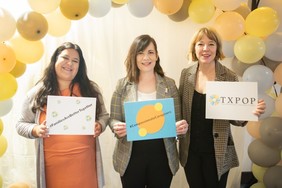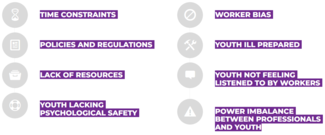
|
|
December 2022 | Issue 14
The Grantee Connection is a quarterly digest featuring new and noteworthy products, information, and lessons learned from select Children's Bureau discretionary grants to inform research, capacity building, and program improvement efforts.
Featured Grantees
|
Collaborating to Improve Permanency Outcomes
Project Description: The Texas Permanency Outcomes Project (TXPOP), funded in 2018, is a project of the Texas Institute for Child & Family Wellbeing and the Texas Center for Child and Family Studies, the Texas Department of Family and Protective Services, and the Children’s Commission. TXPOP develops sustainable best practices utilized by child welfare agencies across Texas to connect children to their families, regardless of their permanency outcome. The project engages in a three-pronged approach that includes a practice model, system engagement, and statewide capacity building to improve permanency outcomes.

Project Highlight: Caregivers can best help children in their care thrive by building a supportive network around the child’s whole family. Establishing a compassionate relationship with the family of the child is healing and transformative for everyone involved. TXPOP’s Compassionate Caregivers campaign provides resources and tools on how to engage with a child’s family in a meaningful way, including strategies and tips for navigating meeting a child’s family for the first time, ways to maintain relationships with the family, and working together with a family to support a child transitioning in and out of the home. The goal of the campaign is to elevate the importance of collaborating with families to create better outcomes for children in care. You can also hear directly from parents and caregivers about why it’s important to keep parents in the loop when their child is in your care.
Learn More: Structural racism is embedded in the laws and regulations of many of the systems and institutions in the United States, including the child welfare system. The Compassionate Caregivers campaign provides resources about how to engage with birth families who may be experiencing structural inequality and trauma. Read more to understand why learning about these issues is critical for caregivers. Additional resources are also included.
Photo provided by TXPOP
|
Addressing Barriers to Authentic Youth Engagement
Project Description: Informed by the lived experiences and professional expertise of youth formerly in foster care, the Quality Improvement Center for Engaging Youth in Finding Permanency (QIC-EY) is a 5-year cooperative agreement, funded in 2021, that aims to bring about systemic culture shifts resulting in intentional policy and practice changes directly related to the child welfare system’s engagement and empowerment of and partnership with children and youth.
To accomplish its goals, the QIC-EY is partnering with eight pilot sites. Between October 2022 and September 2026, these sites will receive support and resources from the QIC-EY to make changes in how they authentically engage children and youth. The information gained through evaluation of the work being done in the pilot sites will help to transform how children and youth are engaged authentically in child welfare systems throughout the nation.

Project Highlight: The QIC-EY’s latest report, Barriers to Authentic Youth Engagement, identifies the biggest obstacles impacting successful child and youth engagement, solutions for services offered, as well as important culture shifts needed within the broader system.
The report identifies eight key barriers based upon interviews with stakeholder groups who were asked to share their personal experiences with authentic engagement. These include time constraints, policies and regulations, lack of resources, youth lacking psychological safety, worker bias, youth ill prepared, youth not feeling listened to by workers, and the power imbalance between professionals and youth. Time constraints, worker turnover, and legal regulations were the most common and specific barriers reported.
This new report will help to inform the work of the QIC-EY and is also available for professionals. Curious about how this report could inform your work? See the suggestions below:
- Have members of your team read specific sections and invite everyone to share three insights from their section.
- Think about which of the eight barriers in the report exist for your work with engaging children and youth.
- Identify the barriers that most acutely affect your youth engagement work and find ways to to chip away at them.
Learn More: To better understand the current landscape of engaging children and youth in child welfare, view the QIC-EY’s environmental scan. The environmental scan identifies strengths as well as areas in need of improvement and is made up of three components: a systematic literature review, a state survey analysis, and expert interviews.
Graphic from the QIC-EY's Barriers to Authentic Youth Engagement
|
Collecting Data on Sexual Orientation, Gender Identity, and Expression
Project Description: The National Quality Improvement Center on Tailored Services, Placement Stability, and Permanency for Lesbian, Gay, Bisexual, Transgender, Questioning, and Two-Spirit Children and Youth in Foster Care (QIC- LGBTQ2S) is a 5-year grant established in 2016 to develop, integrate, and sustain best practices and programs that improve outcomes for children and youth in foster care with diverse sexual orientations, gender identities, and gender expressions (SOGIE). QIC-LGBTQ2S materials are now housed on the National SOGIE Center website, which operates as a hub for providers seeking information on serving LGBTQ2S children and youth and their families.
QIC-LGBTQ2S selected four local implementation sites—Allegheny County (PA), Cuyahoga County (OH), the state of Michigan, and Prince George’s County (MD)—to identify, select, adapt, implement, and evaluate evidence-based, evidence-informed, and/or promising programs and interventions that address the unique needs of children and youth with diverse SOGIE in foster care.

Project Highlight: LGBTQ+ children and youth are overrepresented in foster care and face a range of disparities. How can the child welfare system collect and use data on SOGIE to ensure safe and affirming care for LGBTQ+ youth, caregivers, and family members? This new podcast series on SOGIE data collection explores how this previously invisible population can be seen, heard, and prioritized in child welfare.
-
Episode 1: “Understanding the Importance of SOGIE Data”: Covers what SOGIE data are and why they are important, particularly to young people involved with the child welfare system. This episode is recommended as an introduction to the topic.
-
Episode 2: “Implementing Organizational Change”: Discusses efforts in Cuyahoga County, OH, to safely and effectively collect SOGIE data from young people and the lessons they learned along the way. This episode is recommended for understanding safe SOGIE data collection and related training, coaching, and supervision at the county level.
-
Episode 3: “Storytelling With SOGIE Data”: Describes the decade-long process to collect SOGIE data in Allegheny County, PA, and how data dashboards were used to change the way the workforce thought about it. This episode is recommended for understanding SOGIE data use, data collection improvement, and practical decision-making in a county or community system.
-
Episode 4: “Moving Beyond Data Collection”: Discusses statewide efforts to collect SOGIE data with the Michigan Children’s Services Administration, how they grappled with confidentiality, and the top challenges staff identified. This episode is recommended for understanding SOGIE data collection in a state system and its positive impact.
Learn More: Find additional information and resources on programs and interventions that address the unique needs of children and youth with diverse SOGIE in foster care.
Photo from Podcast Series Collecting Data on Sexual Orientation, Gender Identity, and Expression in Child Welfare
|
Making Data-Informed Workforce Decisions
Project Description: The Quality Improvement Center for Workforce Development (QIC-WD), a 5-year cooperative agreement funded in 2016, was developed to implement and evaluate strategies to strengthen the child welfare workforce. In partnership with eight public child welfare jurisdictions, QIC-WD is studying interventions related to job redesign, telework, technology, onboarding, supportive supervision, hiring, organizational culture and climate, and job-related secondary traumatic stress. The website has information about project sites, workforce analytic tools, and tips derived from the expertise and experience of the QIC-WD team.

Project Highlight: Hiring and retaining new child welfare workers has always been a challenge, but in this tight job market, it seems more difficult than ever. The QIC-WD recently launched two new projects to help public child welfare agencies gain better access to workforce measures and make data-informed decisions about their workforce.
The first project is focused on creating data dashboards in eight agencies. Data dashboards make existing workforce measures more useful to human resources (HR) and child welfare leaders tasked with making decisions related to recruitment, development, and retention.
The second project will work with five teams from across the United States to evaluate their child welfare recruitment strategies in real time. Recruitment is an on-going challenge and very little evaluation information is available to inform the field of child welfare on promising practices. Both projects engage teams of HR and child welfare professionals to work closely with the QIC-WD in a short-term effort to improve the use of local workforce data.
Learn More: Do you have a child welfare workforce issue question? Get your questions answered and hear from experts in the field during the upcoming QIC-WD National Webinar Series. Topics include supporting new workers; supporting virtual supervision as part of a hybrid workforce; measuring diversity, equity, and inclusion; and attracting and hiring workers.
Graphic from QIC-WD's Workforce Data Dashboard Partner Sites
|
|
Grantee Blog:
New National Measures of Court Performance
 Graphic from Judicial, Court, and Attorney Measures of Performance (JCAMP) Volume I: Measures
What is JCAMP?
The Judicial, Court, and Attorney Measures of Performance (JCAMP) were developed by CB and the Capacity Building Center for Courts to help the field understand and improve child welfare court practices. Individuals (e.g., judges, attorneys, court administrators) and organizations (e.g., Court Improvement Programs, attorney organizations) can use these performance measures for child welfare court and systems improvement.
These measures are designed to help any state or tribe dig deeper into areas of interest in legal and judicial practice and monitor improvements. The model measures are surrounded by a suite of materials to help no matter what stage of the system improvement cycle you are in or what resources you have at your disposal. In a sense, they are designed with a ”choose your own adventure” approach recognizing the differences in jurisdictions.
The measures cover five topical categories:
-
Family engagement: Parents, caregivers, children, and youth are involved in their court processes.
-
Due process: All families have access and matters are resolved according to a fair, clear, and reasonable process.
-
High-quality legal representation: All families and the child welfare agency have access to counsel who are trained and equipped to meet accepted standards for attorney practice in and outside of court.
-
Safety measures: Children are protected from harm and safety decision-making occurs at key points in the court process.
-
Permanency: A person has a legal relationship with a safe, stable, and nurturing family that is intended to last a lifetime.
Each category includes the following three focus areas:
| |
What they do
|
Example measures
|
|
Court process measures
|
Measure what happens in the court process, including before, during, and after court. Meant to serve as a starting point for measurement.
|
Do parent attorneys attend hearings?
|
|
Professional practice measures
|
Measure what judges and attorneys do during and between hearings.
|
How do parent attorneys ensure they provide high-quality legal representation?
|
|
Family experience measures
|
Measure how families experience and perceive the child welfare court system.
|
Are parents satisfied with their attorneys' representation?
|
Source: Summers, Gatowski, & Fromknecht. (2022). Judicial, Court, and Attorney Measures of Performance quick start guide. Capacity Building Center for Courts.
In what ways are these different from past court data measures?
The JCAMP measures were developed using a set of guiding principles. The measures:
- Highlight the child and family experience.
- Incorporate equity into implementation and analysis.
- Are usable and flexible for sites and court stakeholders to inform practice.
- Are feasible for sites with varying data capacity to implement.
- Are guided by research evidence and best-practice recommendations.
- Include theories of change for each measure that describe how the measure relates to outcomes for children and families.
- Complement the existing court measures and Child and Family Services Reviews measures.
JCAMP was developed deliberately to not replace existing datasets (e.g., Child and Family Services Reviews measures) but to supplement them—to show a bigger and more detailed picture of the puzzle. Each measure provides a way to connect court practices to safety, permanency, and well-being outcomes. For example, measures have due-process and family-experience components and a description of what research or hypothesis connects those to long-term outcomes. (See the topical categories and focus area chart above.)
The measures were also developed with a group of over 70 individuals with diverse perspectives. The consultants were multidisciplinary (e.g., lawyers, judges, social workers, researchers), multibranch (e.g., agency and court), multijurisdictional (e.g., state and tribal staff and field-testing sites), geographically diverse, and included persons with lived expertise.
You can find more information and download the full JCAMP materials on the American Bar Association or Child Welfare Information Gateway websites.
|
Resources From
Child Welfare Information Gateway

Workforce Recruitment
Visit the webpage.
|

“From Conversations to Relationships: Engaging Teens in Permanency Planning”
Watch the webinar.
|

Child Welfare Practice to Address Racial Disproportionality and Disparity
Read the publication.
|
Grantee News & Updates
- CB recently published new fiscal year (FY) 2023 discretionary grant forecasts. A forecast is a planned funding opportunity that contains actual or estimated dates and funding levels for grants that CB intends to award during the fiscal year. Forecast opportunities are subject to change based on enactment of congressional appropriations. Tip: Filter search results by Administration for Children and Families - ACYF/CB [HHS-ACF-CB] to only see CB opportunities.
- Looking for information on applying for CB grants? Visit the How to Apply for a Grant web section to learn about the complete process—from finding notices of funding opportunities to writing and submitting a strong application.
- Interested in supporting the CB discretionary grant process? Apply today to be a grant reviewer!
Are you a Children's Bureau grantee? SUBMIT YOUR UPDATES AND RESOURCES!
|
|